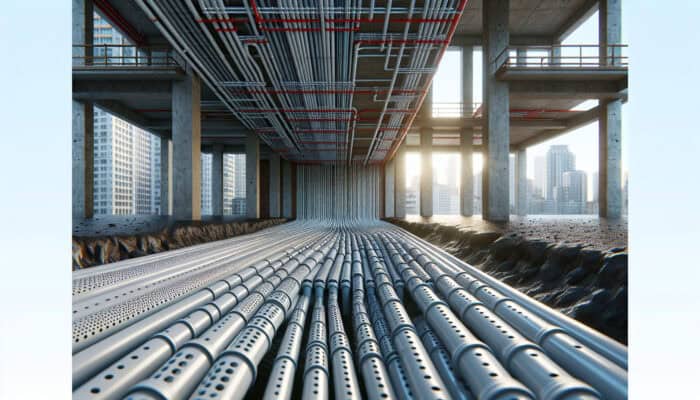Discover Comprehensive Weeping Tile Solutions for Your Richmond Property
Understanding Weeping Tiles: Essential Mechanisms for Home Protection
Weeping Tile Services in Richmond play a pivotal role in effective drainage systems, designed meticulously to control groundwater levels that surround building foundations. These perforated pipes, often made from PVC, function by gathering excess water and channeling it away from structures, thus preventing water damage and preserving the structural integrity of your property. By alleviating hydrostatic pressure, weeping tiles are instrumental in protecting foundations and ensuring the overall stability of buildings, effectively guarding against moisture-related complications that can lead to serious structural issues.
The benefits of implementing weeping tiles are numerous and include:
- Water Damage Prevention: They act as a reliable barrier, significantly reducing the risk of flooding and moisture-related problems in basements.
- Foundation Stability: They help maintain a stable foundation by effectively managing soil moisture levels.
- Cost-Effective Solution: They minimise the likelihood of incurring costly repairs due to water damage.
- Enhanced Property Value: A well-maintained drainage system can substantially elevate the value of your property.
- Improved Indoor Air Quality: They assist in mitigating mould and mildew growth by effectively managing moisture levels.
- Long-Term Durability: With proper installation, a weeping tile system can endure for many years, providing homeowners with peace of mind.
For homeowners in Richmond, a thorough understanding of how weeping tiles operate and the multitude of benefits they offer is essential, especially considering the region's climate, which often presents significant groundwater challenges.
The Importance of Regular Weeping Tile Maintenance for Homeowners
Maintaining weeping tiles on a consistent basis is crucial to ensure that your drainage system functions at its best. Neglect can lead to clogs from silt and debris, which can result in insufficient drainage and expensive repairs. Without regular inspections, homeowners risk encountering unforeseen water damage, which could have been easily avoided through timely maintenance.
Key indicators that your weeping tile system may need attention include:
- Water Pooling: The presence of water around the foundation or inside basements is a clear indication of a problem.
- Visible Cracks: Cracks appearing in the foundation or basement walls may signal potential structural issues.
- High Moisture Levels: Excessive humidity or dampness in the lower levels of your home could indicate a malfunction.
- Musty Odours: Unpleasant smells might suggest the presence of mould or mildew, pointing to moisture-related concerns.
Recognising these signs should prompt immediate inspection and maintenance efforts to address potential issues before they escalate into more significant problems.
Step-by-Step Guide to the Weeping Tile Installation Process
The installation of weeping tiles involves a detailed, multi-step process that requires meticulous planning and execution. The process generally begins with excavating a trench around the perimeter of the building's foundation. Once the trench is formed, the weeping tile is installed at the appropriate depth, ensuring a slope that directs water away from the foundation to facilitate optimal drainage. Following the installation, gravel is placed atop the tiles to enhance drainage efficiency and prevent soil infiltration into the system.
Proper installation is paramount; if performed inadequately, the system may fail to function effectively, leading to water accumulation and consequent damage. Typically, the installation process can take anywhere from one to three days, depending on the size of the property and the complexity of the existing drainage system. Homeowners are strongly advised to engage experienced professionals to ensure a successful installation.
Expert Opinions on Weeping Tile Services Available in Richmond

Advantages of Engaging Professional Weeping Tile Services
Hiring professional weeping tile services in Richmond presents numerous advantages. Experts in this field ensure that both installation and maintenance tasks are executed with precision, markedly reducing the risk of water damage due to improper handling. Professionals boast extensive experience, enabling them to efficiently diagnose and address any problems that may arise, thereby effectively protecting your property.
For example, successful weeping tile installations in Richmond illustrate how a meticulously executed system can transform previously flooded basements into dry, functional spaces. A notable case involved a historic home that suffered from chronic flooding. After a comprehensive assessment, a professional team installed a cutting-edge weeping tile system that effectively redirected water away from the foundation, safeguarding the home's structural integrity and enhancing its overall market value.
Moreover, professionals are equipped with the necessary tools and technology to quickly identify potential issues, saving homeowners time and money over the long term. Their expertise not only maximises the system's efficiency but also provides peace of mind, ensuring that your home remains shielded from water damage.
Common Challenges Associated with Weeping Tiles
Despite their effectiveness, weeping tiles can face a variety of challenges. Common problems include clogs, cracks, and improper installations. Clogs may occur due to the accumulation of silt, roots, or other debris, which severely hampers the system’s functionality. Additionally, cracks in the pipes can cause leaks, while poor installation can lead to inadequate drainage, resulting in water pooling around the foundation.
Frequent causes of weeping tile failure include:
- Poor Installation: An incorrect slope or depth can result in ineffective drainage.
- Soil Erosion: Moving soil can expose weeping tiles, leading to potential damage.
- Debris Buildup: Leaves, silt, and roots can obstruct drainage holes, impairing performance.
- Aging Systems: Older systems may deteriorate over time, experiencing wear and tear.
Conducting regular inspections is vital for early identification of these problems, allowing for timely repairs and maintenance to ensure your system operates effectively.
Choosing the Right Weeping Tile Service Provider for Your Home

Selecting a reputable weeping tile service provider in Richmond is essential for ensuring quality service and effective results. When choosing a provider, prioritise those with substantial experience and a solid reputation in the community. Recommendations from friends or neighbours can also be invaluable in guiding your selection.
To verify the qualifications of a weeping tile service provider, consider taking the following steps:
- Check Certifications: Ensure they possess the necessary licenses and certifications.
- Read Customer Reviews: Look for online testimonials and reviews to assess their reputation.
- Request References: Ask previous clients for references to gauge their satisfaction levels.
- Inquire About Experience: Opt for providers with specific expertise in weeping tiles and drainage solutions.
Making an informed decision can lead to reliable service that effectively protects your home from potential water damage.
How Weeping Tiles Effectively Prevent Water Damage in Richmond
Mechanisms Employed for Efficient Water Diversion
The mechanism through which weeping tiles mitigate water damage is both straightforward and remarkably effective. Weeping tiles capture groundwater via their perforated surfaces, directing excess water away from the foundation. This diversion is critical in preventing water from entering basements or crawl spaces, which could lead to severe structural problems and health hazards due to mould and mildew proliferation.
If water is not redirected properly, it can create increased pressure against the foundation walls, resulting in cracks, structural shifts, and, over time, foundation failure. By ensuring effective water redirection, weeping tiles play a vital role in maintaining a dry and safe living environment for homeowners.
Contributions of Weeping Tiles to Foundation Stability
By effectively managing both ground and surface water around the foundation, weeping tiles significantly aid in maintaining soil stability. Balancing moisture levels in the soil is crucial; excessive water can cause soil expansion and pressure against the foundation, while insufficient moisture can lead to soil shrinkage and settling.
The type of soil surrounding the foundation greatly affects the performance of weeping tiles. For instance, clay soils are more prone to retaining water and expanding, exerting additional pressure on the foundation. Conversely, sandy soils drain quickly and are less likely to pose such issues. Homeowners should carefully evaluate soil types when planning their drainage systems, as this directly impacts the effectiveness of weeping tiles in fulfilling their intended purpose.
Long-Term Advantages of Weeping Tile Systems
A well-functioning weeping tile system offers substantial long-term benefits, particularly in extending the lifespan of a building’s foundation. With effective drainage solutions in place, homeowners can expect significant reductions in moisture-related issues that frequently result in costly repairs and maintenance.
The long-term cost savings associated with weeping tile systems include:
- Lower Repair Costs: Preventing water damage leads to fewer repairs over time.
- Reduced Insurance Premiums: Maintaining a dry home can help lower homeowners’ insurance costs.
- Increased Property Value: A well-maintained property typically commands a higher resale price.
- Extended Lifespan of the Home: Proper drainage contributes to the overall durability and longevity of the structure.
Investing in a high-quality weeping tile system is not just a protective measure; it represents a strategic decision for homeowners seeking to safeguard their investment over the long haul.
Identifying the Warning Signs of Weeping Tile Failure in Richmond
Recognising Visible Water Pooling Around Your Property

Visible water pooling around the foundation or within the basement is one of the most concerning signs that your weeping tile system may be failing. When water accumulates in these areas, it often indicates that the weeping tiles are either obstructed or damaged, hindering proper drainage. Addressing visible water pooling promptly is essential; homeowners should ideally act within 24 hours to prevent further complications.
If left unaddressed, pooling water can lead to severe damage, including mould growth and structural deterioration. Homeowners should respond swiftly by contacting a professional to evaluate the situation and implement necessary repairs or maintenance.
Implications of Elevated Moisture Levels in Your Home
Increased moisture levels in the basement or lower living areas can also indicate issues with the weeping tile system. High humidity or noticeable dampness suggests that moisture is not being adequately diverted, which could lead to mould growth and health risks for the household occupants.
To monitor moisture levels, homeowners can use tools such as hygrometers or moisture meters, which provide readings of humidity in the air and moisture content in building materials. Consistently high readings should prompt a comprehensive inspection of the weeping tiles to identify and rectify the underlying issue.
Consequences of Foundation Cracks and Shifts
Cracks in the foundation or noticeable shifts in the building’s structure are serious indicators that may suggest weeping tile failure. Water pressure against the foundation can cause significant damage over time, leading to costly repairs. Distinguishing between cracks related to weeping tile issues and other foundation problems can be challenging; however, cracks that appear suddenly or are accompanied by water seepage are often linked to drainage failures.
Homeowners should closely monitor any changes in their foundation and consult professionals for a thorough inspection to ensure the structural integrity of the building remains intact.
Effective Strategies for Weeping Tile Services in Richmond
Establishing Regular Inspection and Maintenance Plans
Creating a consistent inspection and maintenance schedule for weeping tiles is a crucial strategy for preventing significant issues. Scheduling annual checks is highly recommended for optimal system performance. During these inspections, professionals can identify potential problems before they escalate into costly repairs.
To formulate an effective maintenance schedule, homeowners should:
- Schedule Annual Appointments: Set inspections for the same time each year to ensure consistency.
- Document Inspection Results: Keep detailed records of inspections and any maintenance performed for future reference.
- Monitor Conditions: Observe any changes in drainage performance or indications of foundation integrity issues.
- Consult Experts: Hire professionals with expertise in weeping tile systems for thorough assessments.
This proactive approach not only guarantees the longevity of the drainage system but also provides homeowners with peace of mind, knowing they are protected from potential water-related issues.
Advantages of Upgrading Outdated Weeping Tile Systems
As technology progresses, older weeping tile systems may become obsolete, failing to meet modern standards or exhibiting signs of damage. Upgrading to contemporary systems can significantly enhance efficiency and prevent future water damage.
When contemplating an upgrade, homeowners should evaluate the cost-benefit ratio. While initial expenditures may be higher, the long-term savings from reduced risks of water damage and lower maintenance requirements often justify the investment. Consulting with professionals can provide valuable insights into the best options available for modernising weeping tiles.
Emergency Repair Services for Weeping Tiles: What You Need to Know
Accessing emergency repair services can be invaluable when weeping tile systems fail unexpectedly. Quick response times are critical in mitigating damage from sudden failures. Homeowners should ensure they have contact information for reliable local services that specialise in weeping tile repairs.
If you suspect an emergency involving your weeping tiles, the first step is to assess the situation promptly. Pay close attention to any visible water pooling, unusual moisture levels, or foundation issues, and contact a professional without delay. Taking swift action can help limit damage and ensure repairs are completed efficiently.
The Importance of Professional Installation of New Weeping Tile Systems
When installing new weeping tile systems, enlisting the assistance of experienced professionals is essential to guarantee proper installation and optimal performance. A well-executed installation not only enhances the efficiency of the drainage system but also prevents future complications related to improper drainage.
When selecting a professional installation service, homeowners should consider:
- Experience and Expertise: Choose a company with a proven track record in weeping tile installations.
- Client Feedback: Seek testimonials from prior customers for insights into the quality of service.
- Warranty and Guarantees: Ensure a warranty is provided for both materials and workmanship.
- Transparent Pricing: Look for providers who offer clear, detailed estimates without hidden fees.
These criteria will help ensure that the new installation operates efficiently for years to come, providing reliable moisture management for your property.
Effective Drainage Solutions for Existing Landscapes
Customised drainage solutions can significantly enhance existing landscapes while preventing water accumulation and erosion. By collaborating with experts, homeowners can design drainage systems that seamlessly integrate with their outdoor spaces, thus protecting the property from water damage.
To improve landscapes while optimising drainage, homeowners should consider:
- Grading Adjustments: Ensure that grading directs water away from the foundation.
- Installing French Drains: Implement French drains for effective water diversion in landscaped areas.
- Creating Rain Gardens: Introduce rain gardens to absorb excess rainwater and enhance biodiversity.
- Using Permeable Paving: Incorporate permeable materials to allow water to seep through and reduce runoff.
These strategies not only enhance the landscape’s beauty but also protect the home from water-related issues, ensuring a resilient and visually appealing outdoor space.
Understanding Costs Associated with Weeping Tile Services in Richmond
Key Factors Influencing the Cost of Weeping Tile Installation
Several factors significantly affect the costs associated with installing weeping tiles. The size of the property is a primary consideration; larger homes usually require more extensive drainage systems. Additionally, the type of soil can greatly impact installation expenses. For example, rocky or clay soils may necessitate more extensive excavation and preparation work.
Professional assessments are invaluable in providing accurate cost estimates, as they take into account existing conditions and potential complications, ensuring a comprehensive understanding of the project’s scope. On average, homeowners in Richmond should anticipate installation costs ranging from $3,000 to $8,000, depending on these influencing factors.
Costs of Weeping Tile Maintenance and Repair
Understanding the costs associated with maintaining and repairing weeping tile systems is essential for effective financial planning. Regular maintenance is typically much less expensive than repairs resulting from neglect. Homeowners should budget for annual inspections and routine cleaning, which can usually be performed at a relatively low cost.
Annually, homeowners should expect to spend between $150 and $500 on maintenance. However, if repairs become necessary, costs can rise dramatically, emphasising the importance of regular upkeep to avoid unexpected expenses.
Money-Saving Techniques for Weeping Tile Services
Homeowners can adopt various strategies to save money on weeping tile services without compromising quality. For example, engaging in DIY maintenance is an effective way to reduce costs. Tasks such as clearing debris from surface drains or monitoring for visible signs of failure can often be managed by homeowners themselves.
Additional cost-saving strategies include:
- Investing in Quality Materials: Selecting durable materials can lower long-term replacement costs.
- Comparative Shopping: Obtain multiple estimates from different contractors to find the best deal.
- Annual Maintenance Checks: Schedule regular inspections to catch issues early.
- Participating in Local Workshops: Attend workshops to learn DIY maintenance tips and best practices.
By adopting a proactive approach, homeowners can effectively maintain their systems while saving money in the long run.
Comparative Analysis of Weeping Tile Materials and Their Costs
Different materials used for weeping tiles come with varying costs and durability levels, which can significantly affect overall project expenses. PVC, clay, and concrete are among the most commonly utilised materials, each offering unique advantages and disadvantages.
PVC is lightweight and resistant to corrosion, making it a popular choice for many homeowners. Clay tiles, while durable, may be more vulnerable to cracking. Conversely, concrete provides strength but can be heavier and more challenging to install.
Homeowners should consider:
- Cost: Generally, PVC is the most budget-friendly option, whereas clay can present a higher price point.
- Durability: Concrete offers longevity but may be prone to cracking over time.
- Ease of Installation: PVC is easier to install compared to heavier materials such as concrete.
- Maintenance Requirements: Both PVC and clay typically require less maintenance than concrete alternatives.
Understanding these differences empowers homeowners to make financially responsible choices tailored to their specific drainage needs.
Exploring Financial Assistance and Incentives for Weeping Tile Installation
Homeowners in Richmond may discover various financial assistance options and incentives designed to support the installation of weeping tiles. Local programmes often provide grants, rebates, or financing options to encourage homeowners to invest in effective drainage solutions.
Types of financial aid available may include:
- Government Grants: Investigate municipal or provincial grants aimed at preventing water damage.
- Rebates on Installation Costs: Some programmes offer rebates for new installations.
- Low-Interest Financing: Explore financing options that facilitate affordable payment plans.
- Tax Incentives: Certain improvements may qualify for tax deductions, offering additional savings.
Exploring these financial options can significantly reduce the out-of-pocket expenses associated with weeping tile installation, making it a more feasible investment for homeowners.
Frequently Asked Questions Regarding Weeping Tiles
What Are the Primary Functions of Weeping Tiles?
Weeping tiles are specialised perforated pipes used for managing groundwater around building foundations. Their primary function is to prevent water damage and maintain structural integrity by effectively redirecting excess moisture away from the foundation.
How Often Should Weeping Tiles Be Inspected for Optimal Performance?
It is highly recommended to inspect weeping tiles at least once a year to ensure they are functioning correctly and to identify any potential issues before they develop into more serious problems.
Is DIY Installation of Weeping Tiles Feasible?
While DIY installations are possible, hiring professionals is generally advisable to ensure proper installation and to guarantee the optimal performance and longevity of the drainage system.
What Are the Indicators of Weeping Tile Failure?
Signs of failure include visible water pooling, increased moisture levels in the basement, and cracks in the foundation, which may indicate serious problems with the drainage system.
How Can I Maintain My Weeping Tiles Effectively?
Regular maintenance involves clearing debris from surface drains, scheduling annual inspections, and monitoring for signs of damage or blockage to ensure the system remains effective and efficient.
What Is the Average Cost for Weeping Tile Installation in Richmond?
The average cost for weeping tile installation in Richmond typically ranges from $3,000 to $8,000, depending on factors such as property size and soil conditions.
Are There Different Materials Available for Weeping Tiles?
Yes, common materials include PVC, clay, and concrete, each offering different costs, durability, and maintenance requirements that homeowners should consider.
What Should I Do If I Notice Water Pooling Around My Foundation?
If you see water pooling, it’s crucial to contact a professional immediately to assess the weeping tile system and determine the necessary repairs or maintenance to prevent further damage.
Can Upgrading My Weeping Tile System Save Money in the Long Run?
Upgrading to modern systems can enhance efficiency and reduce long-term maintenance and repair costs associated with outdated or damaged systems.
Are There Financial Incentives for Installing Weeping Tiles?
Yes, homeowners may have access to government grants, rebates, or financing options that can help offset the costs of installing weeping tile systems, making it a financially viable choice.
Connect with us on Facebook!
Presented By: Weeping Tile in Richmond
The Article: Weeping Tile Services in Richmond: Your Canadian Solution First Published On: https://pacificbluemechanical.ca/
The Article: Weeping Tile Services: Your Richmond Canadian Solution first appeared on https://writebuff.com
The Article Weeping Tile Solutions for Richmond Homeowners Was Found On https://limitsofstrategy.com


